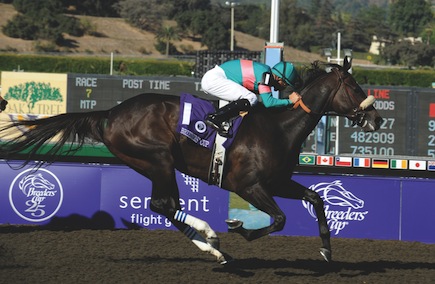This article appeared in the November 2010 issue of Louisville Magazine. To subscribe, please visit loumag.com.
Say you’re a horse. An ambitious horse. How would you, a fleet-footed quadruped, sign up to run in the Breeders’ Cup?
It starts at birth. Actually, before birth. Really, before conception. Every year stallion owners pay a fee equal to a particular stallion’s advertised stud price to the Breeders’ Cup. Now, all foals the stallion sires are eligible for nomination. Each foal from eligible stallions pays a one-time $500 lifetime nomination fee, granting lifetime eligibility to the Breeders’ Cup. But the horses still have to earn one of the 196 total berths in the 14 Breeders’ Cup championship races. Because all races are limited to a maximum of 14 entries, the following criteria affect how the fields are assigned.
- Some horses earn entry to the Cup by winning one of the 65 officially sanctioned Breeders’ Cup Challenge Races. These “Win and You’re In” heats take place all over the United States as well as in Canada, Hong Kong, Australia, England, Ireland and France.
- Another handful of horses are elevated into Cup championship competitions based on the points they accumulate in graded stakes races.
- Finally, an international panel of experts selects seven of the 14 horses in each championship race.
In hopes of boosting the number of international competitors, the Breeders’ Cup is reducing its nomination fees for international competitors beginning next year. It also announced plans to pay travel costs and entry fees for the Win-and-You’re-In victors of sanctioned races in an effort to increase the field of overseas competitors. “We really wanted a Breeders’ Cup win to say: This horse is the best horse in the world,” says Dora Delgado, senior vice president for the Breeders’ Cup.
But travel stipends only cover part of the recruiting problem. Unlike in the United States, few Thoroughbreds around the world are nominated for Breeders’ Cup. European horse owners nominated only 1,200 of the continent’s 18,000 foals eligible in 2009. In the rest of the world, only 25 foals of an estimated 50,000 eligible were nominated. And late nominations can be prohibitively expensive.
To combat this, the cost of stallion nominations for international competitors will drop in 2011 to half of a stallion’s stud fee for Northern Hemisphere competitors, and to 25 percent of stud fee for Southern Hemisphere horses. Further, all foals born of those stallions would be automatically eligible for Breeders’ Cup competition. Finally, late-nomination fees are expected to drop dramatically to encourage a quick increase in international competitors, also starting in 2011.
Photo: Courtesy Breeders' Cup



